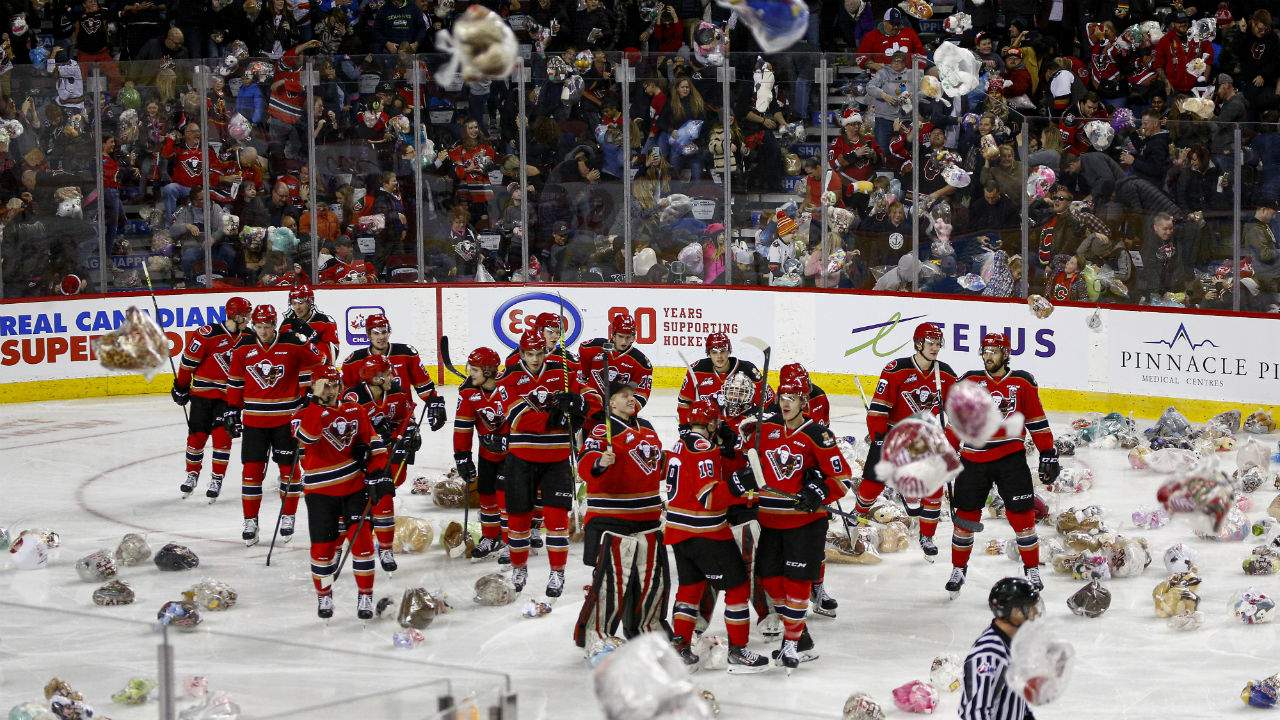TORONTO — Among all of hockey’s traditions, few are so unapologetically joyous, so shamelessly cheery, as the teddy bear toss.
The concept itself is so lovely it’s near absurd. Invite fans to bring teddy bears, of all things, to the rink. Get the word out — when the home team scores its first goal, let the bears fly. Watch them rain down with reckless abandon, the ice disappearing underneath the mountain of plush that’ll later be sent off to children’s hospitals and other local organizations in need.
We’ve all seen the videos of the grand chaos, with the WHL’s Calgary Hitmen and the AHL’s Hershey Bears regularly taking over the internet around the holiday season courtesy of their legendary tosses.
What we don’t see is the massive web of coordination that goes into planning and carrying out the toss — the hundreds of volunteers working away in the bowels of the Scotiabank Saddledome and the Giant Center to corral, count and sort the bears, and to eventually get them into the hands of the kids who most need a reason to smile. It’s not a matter of hours or days, but in fact weeks and months.
That being the case, Sportsnet spoke to North America’s two preeminent toss specialists to get the low-down on how such an event comes together, and what it all means for those involved.
Nearly a year out: Mapping out the toss
“It starts fairly early for us,” says the Hitmen’s assistant manager of business operations, Rob Kerr, whose club’s most recent toss fell on Dec. 1. “Actually it’ll start almost right away now with scheduling.”
Let’s rewind the clock back to the early stages of the 2019 toss, that just brought in 25,025 bears, back to square one.
Like Kerr says, it starts early. The club sits down in January to pour over analytics that help pinpoint the best potential date, and to hammer out the early plan for promotion with the company sponsoring the toss.
“Then the next part is the ticketing component — it’s our premier game. There’s no bigger game on our schedule,” Kerr explains. “Many people who come to this game may not come to another Hitmen game in a year, but will religiously come to this game. … It’s a matter of ensuring our group sales department has what they need, making sure we’ve got inventory, and then planning our launch in the fall.”
Five months out: Planning the count
As winter gives way to summer, the Hitmen begin pinning down the total number of bears to aim for. They check in with the 70-plus organizations that will receive the plush — the children’s hospital, the food bank, small churches around town, and a number of other organizations throughout Calgary — to get a sense of how many bears each are hoping for. When August hits, the club delivers them news of the date of the toss, how the night will go down, and how the post-toss pickup procedure will go.
“I would say from a behind-the-scenes organizational standpoint, our first meeting of gameday operations would be late September, early October,” Kerr says. “We have a fairly good schedule right now of what we need to do and when we need to do it and who does it.”
Wrangling the volunteers to help make the toss possible is a logistical feat in itself, though the Hitmen definitely aren’t short on willing participants. The Children’s Hospital and the Girl Guides provide volunteers to help the team out, as does the toss’ sponsor — in 2019, Enmax. With a community well-versed in the ways of the toss and showing up on gameday in 2018 up to their gills in bears, the Hitmen opt to beef up their volunteer contingent for this year’s iteration.
“We got 29,635 bears last year, and we were counting bears for five-and-a-half hours,” Kerr recalls — a tough ask even for the most dedicated of volunteers. “…So we decided to go with two shifts this year. One shift of volunteers would be there from the beginning of the game to the end of the game — they would be made up of Enmax staff that wished to volunteer, Calgary Children’s Hospital staff and a few other notables from around our office. The second shift, which was going to come in at the end of the game, we put that out to staff and to our season ticket holders.
“We had in the neighbourhood of 90 volunteers for the first shift, and then 50 volunteers for the second shift.”

One week out: Pinning down the logistics of the toss
A week out, the toss team meets almost every day. They plan out the tetris-esque arrangement of the Saddledome’s back parking lot — when the bears are eventually collected, they’ll be housed in cube vans for the next day’s pickup and delivery to the organizations the bears are intended for. There’s also a school bus full of students who will work alongside the team’s volunteers. All have to be twisted and turned and arranged to fit into the back lot.
Inside, arranging pieces in the space allotted is no simpler.
“One of the challenges we have with the Saddledome is that there’s not a lot of available space — there’s not a lot of banquet rooms or just open space. We’re full all the time,” Kerr says. “So we worked with our building staff this year to create some unique opportunities for counting and sorting — we actually set up seven or eight tables right beneath the stands.
“We tarped underneath the stands so nobody would get beer and pop on them, but literally we were counting bears right underneath the stands this year.”
We’ll get to the counting, but first, the checklist:
All bears tossed onto Saddledome ice have to be in a plastic bag — a rule necessitated by the fact that many of them will later be headed for sterile areas within the Children’s Hospital. The team provides the bags — multiple sizes to accommodate any bear brought through the front doors. That’s the first item on the checklist.
“Do we have the bags? Where do the bags go? Do we have the staff in place? Where do the volunteers go?” Kerr runs through the list. “We need to distribute tickets and wristbands to volunteers so we can smoothly work through security.”
Three days out: Coordinating the post-toss pickup
With the 2019 toss set for Sunday, Thursday calls for pinning down the post-toss details with the organizations that’ll receive the bears on Monday.
“We need to communicate to all 70-plus agencies their time and where they come to pick up the bears,” Kerr says. “So along with the planning and the stuff we already institutionally have in place, we have to make sure that that is ready to roll.”
Friday’s good for a final check on all fronts, ensuring all wrinkles are ironed out, all aspects of the plan iron-clad and ready to roll out with pin-point precision. Saturday, the toss team takes a day off, a calm before the next days’ storm.
[relatedlinks]
The morning of: Preparing the rink
“Sunday we’re in here real early,” Kerr says. With the game at 4 p.m., the crew heads in for 9 a.m. “First thing we do is trucks. Second thing we do is take the palette of plastic bags, distribute them throughout the building to different points of entry. We have a Dodge sponsorship — Dodge puts a truck out on the ice when we’re collecting bears — so we have to bring that into the building, clean it, make sure it’s ready to go out on the ice.”
They run through one last check to make sure all volunteers who will be in the building that afternoon have tickets and wristbands and anything else they need.
The final hours: Doors open
“Ninety minutes before the teddy bear toss, the doors open. That’s a half-hour early for us,” Kerr says. “From there, the big thing is that different points of entry will run out of bags quicker, so we’re constantly on the move for 90 minutes moving bags around and making sure everybody has bags.”
A marching band from Bishop Grandin High School is on hand to add to the festivities once they kick off. The toss team makes sure the band is where they need to be and ready to go whenever the time comes.
“The anthem then gets played. You hope and pray that everyone’s in place.”
The Toss
It only takes Hitmen centreman Carson Focht a minute and a half to cue the avalanche, deflecting the puck past Red Deer Rebels netminder Byron Fancy to give the crowd the green light to start chucking. There’s 17,346 filling the ‘Dome’s stands — the team’s highest number of the season, and it’s not particularly close — and as the stuffed animals starts flying, it seems every single one has a bear to add to the pile.
The ice is obscured as the plush piles up — for a moment, as the bears fly through the air, the whole rink seems only a receptacle for catching this onslaught of teddies.
For Kerr’s team, this is the opening whistle.
“As the bears are starting to stream down on the ice — it takes probably 15-20 minutes for the bears to stop being thrown — our volunteers are coming down,” he says. The Dodge truck heads to centre ice with Santa Claus and Mrs. Claus, behind them a trolley with bags for volunteers and Hitmen players to start corralling bears. After nine or 10 bags are filled, the truck leaves with the ceremonial first batch, and the real work begins.
“Once the truck’s off the ice, we create basically a fire brigade, a human line right out to the end of the building and we just pass bags of teddy bears. And then behind where our Zamboni comes out, we create what is [called] Teddy Bear Mountain. … It’s approximately three stories tall when we’re off the ice. That takes us about 15 minutes total. They go do a dry scrape, the game continues.”
Deep in the ‘Dome, the game has just begun.
The Count
Roughly 30 tables are spread throughout the arena’s concourse, with volunteers divvied up to sort bears by size and quality. About one per cent are culled out, deemed not clean enough to send the hospital’s way, but the rest are counted, sorted, taken by a different group of volunteers to a back door, and handed to the team’s accountant.
“He acts as the counter. So the bags are read off to him, he reads the number back, and then the bags are taken out and placed in trucks. We do that until all the bears are counted.”
With the beefed-up volunteer crew, and the process refined down to a sweet science, the toss team manages to get all 25,025 bears collected from the ice, sorted, counted and into the trucks in about four-and-a-half hours. They head home for a well-deserved rest.
From the ‘Dome to the community
The toss team is back at the rink the next morning at 7 a.m., met by a new crew of volunteers from Enmax. The Hitmen players arrive soon after, followed by the first of the organizations picking up their bears. Fresh off their overtime loss the night before, the players are there, all smiles, handing out the bears as each organization rolls through at their allotted time.
“The last thing we do is we go and visit the Children’s Hospital,” Kerr says. “We, along with Enmax and all of our players, go and distribute about 400 bears to Calgary Children’s Hospital.
“That’s it in a nutshell.”
It’s a truly staggering effort from start to finish, and that whirlwind recap covers just one iteration of one team’s toss — a number of other WHL teams stage their own versions, too. And while the Hitmen have reigned as kings of the toss on this side of the border, States-side, it’s the AHL’s aptly named Hershey Bears that have taken the crown.
The Washington Capitals’ minor-league affiliate is fresh off breaking the world record for most bears collected, after more than 45,000 hit the ice earlier this month.
Though the effort to ensure that record-breaking toss ran smoothly was as gargantuan as the Hitmen’s, the prize at the end of the road more than makes up for it.
“It’s nice that there was a world record set, but you know, accolades aside, at the end of the day we’re helping to put smiles on children’s faces,” says Melissa Stradnick, who leads the AHL club’s post-toss process. “That means more to our organization than absolutely anything else. We’re so grateful that we’re able to make such an immense impact on so many children’s lives.”
This is what #TeddyBearTossHershey is all about#HersheyBearsCares https://t.co/zzMKQH7yRZ
— Melissa Stradnick (@MStradnick) December 5, 2019
That eventual heartwarming impact isn’t lost on the AHL faithful either, who show out in full force to support their team’s efforts — and the numbers prove just how far that care extends.
“The town of Hershey physically doesn’t even have enough people to account for all those teddy bears,” says team broadcaster Zack Fisch. “So our reach goes well beyond, to the entire Central Pennsylvania community. For me, that’s the most powerful part.”
About 3,660 kilometres northwest of them, Kerr and the rest of the Hitmen’s team feel the same. Both clubs acknowledged a healthy competition, and respect, for the other’s efforts. But at the end of the day, all involved are crystal clear on why exactly these hours, days, weeks and months are poured into this process.
“It’s what we do,” says Kerr. “We are very much about family and very much about community. It’s really, really incredible that you can get 25,000 stuffed animals and spread them around Southern Alberta to small groups, little churches, the Children’s Hospital, the Calgary Food Bank, you know, all these different groups. And you get these texts — or now with social media you get these tweets — ‘This is incredible, 14 years ago our son was in the hospital and he got a little bear from a Calgary Hitmen player. He still has it today.’ That’s the stuff.
“For me, it really emphasizes what we’re all about. Our biggest games of the year are all based on community initiatives — that’s what we do. That’s where we fit. … That’s who and what we are, and it really culminates in the teddy bear toss.”










